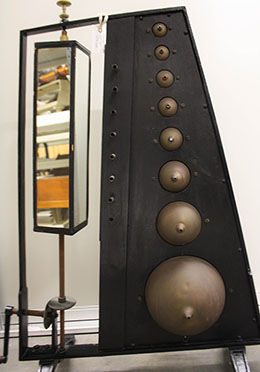The story of sound
 An exhibition telling the story of the history of sound opens this weekend (Saturday 15 March) at the University of St Andrews.
An exhibition telling the story of the history of sound opens this weekend (Saturday 15 March) at the University of St Andrews.
Making Waves: Innovation in the Science of Sound looks at the development of sound over the last 200 years.
It showcases rare and fascinating objects from the University’s Recognised Collection of Historic Scientific Instruments, many of which have never before been displayed to the public.
The exhibition curators, who are students of the University’s Museum and Gallery Studies programme, have delved into the history of the collection to show how innovative objects are being adapted today for ground-breaking research in the life of sea mammals and underwater sonar.
The free exhibition will run at the Gateway Galleries on the North Haugh until 17 May.
Alison Hadfield, Learning & Access Curator, University of St Andrews commented, “This is a really exciting opportunity for members of the public to see some spectacular – and historically significant – scientific instruments made and collected by the University for cutting-edge research into acoustics. The students have also come up with an imaginative events programme, which we expect to be very popular.”
Highlights of the exhibition include:
A complete bench of ‘Chladni Plates’ which for the first time made sound waves visible.
In 1787 physicist and musician Ernst Chladni recorded that when he poured sand onto a metal plate and then stroked the edge with a violin bow, the sand vibrated and settled in a range of beautiful patterns. Musical instrument-makers still use this technique to check the acoustic properties of violins and guitars.
Helmoholtz’s Double Siren, created to measure and alter tone.
Hermann Von Helmholtz’s discoveries to help measure pitch and tone with unprecedented accuracy were built on and adapted by his successors. Not only does the collection include some of Helmholtz’s own creations, but also this Double Siren. Based on his published designs, Rudolph Koenig built this instrument to analyse how tone can be altered by the flow of air through two discs with a series of holes, rotating at specific speeds.
Koenig’s Apparatus for the analysis of sound which made sound visible through an adjustable flame.
Also known as a ‘manometric flame apparatus’ this instrument won a gold medal at the International Exhibition in London, 1862. It allowed us to visualise sound through changing the air pressures in its eight resonators. These changes affected the height of the flame which was surrounded by mirrors to help observers see more clearly.
While many of the instruments were expertly crafted by the most prestigious makers of their day, others were improvised and mended by university staff and students. Scientists at the University of St Andrews often took instruments to pieces and reassembled them to learn how they worked; a set of three organ pipes had one replaced with thin cardboard, to see how the thickness might affect sound. Three matching tuning forks have had one replaced with a wooden, homemade version tuned to the same note; this is an example of students trying to recreate an existing model. These were used alongside many other teaching tools such as wave models, all carefully catalogued by Dr William Swan who was a Professor of Natural Philosophy from 1859 to 1880.
The exhibition concludes with some remarkable modern-day applications of these nineteenth century innovations in acoustic sciences. The technology that men such as Helmholtz and Koenig developed is now being used in high-resolution sonar systems to rebuild shipwrecks digitally, to explore the ocean floors and to track dolphins and whales using underwater microphones or recording devices called D-Tags.
As part of their innovative training, the students on the Museum and Gallery Studies course are required to create a professional public exhibition. They learn how to carry out research, raise funds, locate and negotiate loans, handle and display works of art and historical artefacts, write catalogues and labels, and run events and educational programmes.
One of the students, Anna James, said,“Organising the exhibition has been like a crash course into the real world. There have been a lot of long nights, but it’s incredible to be able to work with these fascinating instruments and to have this level of trust and responsibility placed upon us.”
Making Waves: Innovation in the Science of Sound runs at the Gateway Galleries, St Andrews 15 March – 17 May. Information on the full event programme.
ENDS
Events
The exhibition is free to visit and will be accompanied by a varied events programme. This includes adult lectures and workshops, an object handling session, and fun craft and science activities for all the family. Look out for our special events during National Science and Engineering Week on 23 March and the Festival of Museums 17 May.
Note to Editors
About the Gateway Galleries
The Gateway Galleries is a temporary exhibition venue. There are around four exhibitions each year, on a range of subjects, drawing on the University’s and other collections. The gallery is open Monday to Friday from 9am to 3.45pm and 12 noon to 4pm on Saturdays.
Further details can be found on the museum website: www.st-andrews.ac.uk/museum
Note to Picture Editors
Photographs can be taken during the installation 10- 14 March, but must be arranged in advance. Photos of the exhibits can also be provided; some audio and visual files of instruments are also available for use. For more information please email Anna James at [email protected] or phone 07842 074881.
You are invited to attend the exhibition opening on Friday 14 March, please RSVP via email. All students will be available for photographs.
Category Research